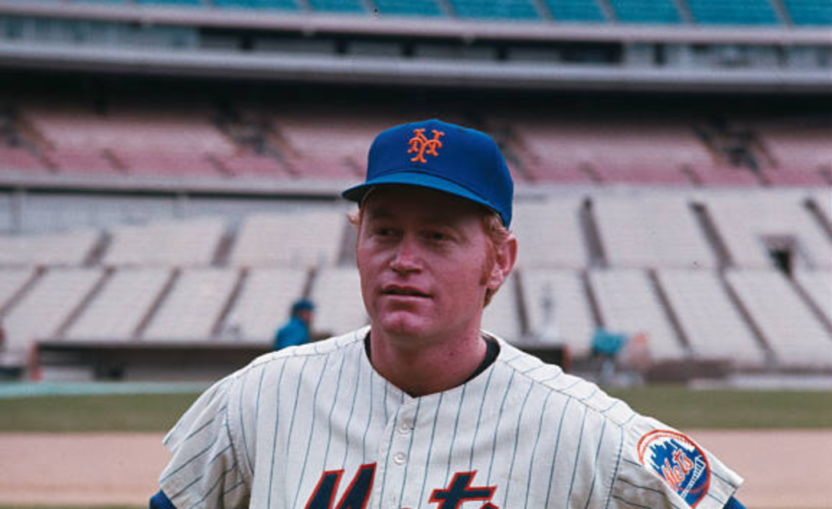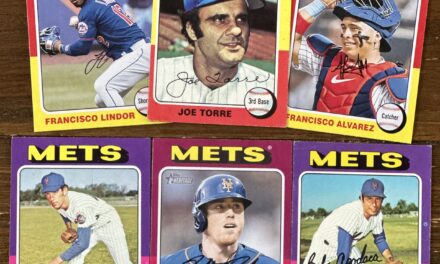
Ask a Mets fan about the darkest days in franchise history. Many will have June 15, 1977 listed somewhere, the day the Mets traded Tom Seaver to the Reds. Some might point to November 1, 2015 (WS loss to the Royals), October 21, 1973 (WS loss to Oakland), or, gasp, October 26, 2000 (WS loss to the Yankees). I’ll put December 12, 1975 near the top of the list.
On that day, the Mets, dealt fan favorite Rusty (Le Grand Orange) Staub to the Tigers for pitcher Mickey Lolich as headliners in a four-player trade. The move was, to this young fan, stunning. Why would they trade Staub? After becoming a Met in 1972, he had led Mets offensively to the 1973 World Series, hitting three home runs in the NLCS, and posting a .423 BA in the World Series. In 1975, Staub had set a franchise record for RBIs in a single season with 105, becoming the first Met to drive in more than 100 runs in a season.
Getting back to the question above, why did they trade him? He did not have a contentious relationship with the front office, as did Seaver toward the end of his Mets’ tenure. The answer is that Staub was one year away from becoming a 10/5 player, and with 10 years in the majors and five with one team, he could have vetoed trades. So, the Mets dealt him while they could (and before he could seek a higher payday).
Let’s talk about the return. The Mets obtained 35 year-old Mickey Lolich, who had some very good years in Detroit, with 25 wins in 1971 and 21 wins in 1972. However, he had not had an above .500 record since 1972, and his ERA had gone from 2.50 in 1972, to 3.82, 4.15, and 3.78 in the next three seasons (keep in mind, offense in baseball was not as it is in current day). Lolich was a 10/5 player, and initially delayed finalization of the trade by contemplating exercising his veto power.
Lolich agreed to become a Met, and was in Queens for one season. He went 8-13 that year, and to be fair, was victimized by the Mets weak offense in 1976. He had a 3.22 ERA that year, and had a respectable WHIP of 1.22. He allowed less than a hit per inning that season, posting a K/9 rate of 8.6.
In Detroit over four seasons, Staub, 31 at the time of the trade, slashed .277/.353/.434 with 70 home runs and 358 RBIs. It’s fair to say that the Tigers got the better end of that deal.
The Mets had obtained Daniel Joseph Staub before the 1972 season, trading Tim Foli, Mike Jorgensen, and Ken Singleton to the Expos in return. Staub, a New Orleans native who began his career with the Houston Colt 45s, was a very good player with Montreal, accumulating an 18.5 bWAR over three seasons. The Mets had acquired a five-time all star in his prime. Staub did not disappoint in New York.
He was limited to 66 game sin 1972, and put up a slash line of .293/.372/.452 with 9 home runs and 38 RBIs. In the pennant-winning season of 1973, Staub played in 152 games (.279/.361/.421 15 HR, 76 RBIs). He was injured in May of that season, and played through the pain for much of the season. In the NLCS, he separated his shoulder in game four making a catch while crashing into the wall. He missed game five, yet played in the World Series and was able to hit .423, as noted above, with one home run.
You can see the catch on which Staub was injured in the video below. It’s the second one of two excellent catches in the video. Staub was an outstanding outfielder in his early years, with a very strong throwing arm.
After returning to Montreal from Detroit during the 1979 season, Staub played for the Texas Rangers in 1980 before coming back to the Mets in 1981, where he remained through the 1985 season, his last. He became an outstanding pinch hitter in his later years in Flushing. In 1983, he had hits in eight consecutive pinch hitting appearances, tying a National League record, and tied a the Major League record with 25 pinch-hit RBIs.
Staub ended his playing career with a slash line of .279/.362/.431, along with 292 home runs and 1466 RBIs over 23 seasons. Staub was enshrined in the Mets Hall of Fame in 1986. He worked in the Mets television booth from 1986-1995.

Staub owned a popular restaurant in New York (Rusty’s), and opened a second restaurant of the same name to build upon the success of the first. One thing that differentiates Rusty from most other players is the depth of his philanthropic work. He founded The New York Police and Fire Widows’ and Children’s Benefit Fund in 1985, whose work provides for families of police officers and firefighters who lost their lives in the line of duty.
Rusty Staub passed away on March 29, 2018, opening day of the Mets’ season. Staub played a total of nine seasons as a Met, and made his mark both on and off the field. For these reasons, particularly the charity work, I’d like to see him honored at Citi Field, alongside Tom Seaver (when that time comes), Gil Hodges, and Joan Payson.
Staub wore numbers 4 and 10 as a Met. Since Steve Cohen is more amenable to honoring Mets’ history, I think it would be a nice gesture to retire one of those numbers, to acknowledge the life and career of a very good Met and better man.















